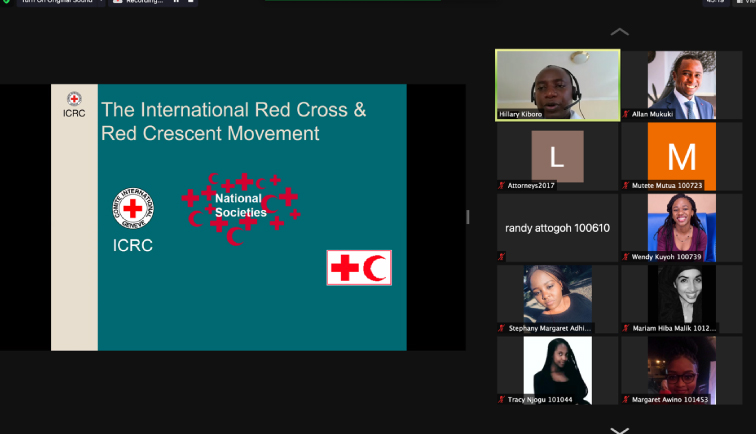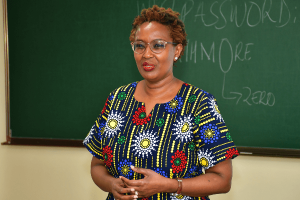International Committee of the Red Cross (ICRC) Guest Lecture

On Wednesday 10th March 2021, the 4th Year International Humanitarian Law (IHL) class were privileged to receive a guest lecture by Mr. Hillary Kiboro, legal advisor to the International Committee of the Red Cross (ICRC) in Nairobi, Kenya. Mr. Kiboro gave a riveting, interactive lecture on the role of the ICRC in the implementation of IHL, which was packed with insights into the noble work conducted by the ICRC in implementing IHL during armed conflicts.
Nature and Mandate of the ICRC
The ICRC is a neutral, independent and impartial international organization whose exclusive humanitarian mission is to protect the lives and dignity of victims of war and internal violence and to provide them with assistance. As Mr. Kiboro aptly noted, the ICRC’s origins are closely intertwined to the origins of IHL itself, with the organization being officially formed in 1863 as a result of Henry Dunant’s 1862 world-renowned memoir “A Memory of Solferino”. The ICRC facilitates dialogue between parties to a conflict (states or non-state actors) in a bid to promote the respect of IHL during armed conflict. Therefore, the protection ICRC provides is based on upholding the rule of law, rather than actual physical protection.
It was interesting to note that unlike other international organisations which are formed by states and function on the basis of membership of states, ICRC was founded by private individuals and is registered as a private entity in Switzerland. However, the mandate of the ICRC is what elevates it to the status of an international organization. This mandate is given by the 1949 Geneva Conventions to conduct specific humanitarian work during armed conflicts, as well as through the Statute of the International Red Cross and Red Crescent Societies.
Components of the Movement
In discussing the components of the ICRC Movement, Mr. Kiboro noted that the Movement comprises several different components including the ICRC itself, the National Red Cross and Red Crescent Societies, and the International Federation of Red Cross and Red Crescent Societies (IFRC). The bodies that govern the Movement are the International Conference of the Red Cross and Red Crescent, the Council of Delegates and the Standing Commission.
- National Red Cross and Red Crescent Societies
National Red Cross and Red Crescent Societies embody the work and principles of the ICRC Movement in 193 countries. National Societies act as auxiliaries to the public authorities of their own countries in the humanitarian field and provide a range of services including disaster relief, health and social programmes. During armed conflicts, National Societies assist the affected civilian population and support the army medical services where appropriate. All National Societies must first be recognized by the ICRC, on the basis of a set of conditions for recognition, in order to become part of the Movement. Subsequently they may become members of the International Federation, the National Societies’ umbrella organization.
- IFRC
The IFRC operates on the basis of the Principles of the Red Cross and Red Crescent Movement to inspire, facilitate and promote all humanitarian activities carried out by its member National Societies to improve the situation of the most vulnerable people. Founded in 1919 with its Secretariat in Geneva, the IFRC directs and coordinates international assistance of the Movement to victims of natural and technological disasters, to refugees and in health emergencies. It acts as the official representative of its member Societies in the international field. It promotes cooperation between National Societies and works to strengthen their capacity to carry out effective disaster preparedness, health and social programmes.
Core Humanitarian Activities
- Protection in War
The ICRC strives to protect civilians, prisoners of war and detainees as well as other parties who do not directly participate in hostilities during armed conflicts. This is primarily done through ensuring that the rules of IHL are respected during the conflicts, so as to ensure these parties are protected. The ICRC also conducts visits to persons detained in connection with armed conflicts and unrest and strives to implement the specific provisions of the Geneva Conventions in relation to the treatment of prisoners of war. Mr. Kiboro stressed that this was a critical component of the work ICRC does, therefore the ICRC makes a point of stipulating certain pre-conditions in order to do so.
First, the ICRC must have geographical access to all prisoners of war and detainees in every area and be able to do so for as many times as necessary. Second, they must be allowed to talk to all the detainees of their choice and can therefore not be restricted to speak to only certain detainees. Third, they must also be allowed to conduct a private interview with the detainee without witnesses, ensuring that the detainees can speak freely. They must also be able to keep a record of all detainees and prisoners of war, as well as have access to the prisons record, so as to encourage dialogue with the authorities on how to prevent enforced disappearances and extrajudicial executions.
Another aspect of protection in war is the restoration of family links. This involves reuniting families that have been separated by armed conflicts. This is done through exchanging Red Cross messages, searching for missing persons, reuniting unaccompanied children with their families, and repatriating prisoners at the end of hostilities. What was particularly striking here was the crucial role the network of the ICRC plays in reconnecting these separated families, as once Red Cross Messages-which contain the personal information of those seeking out their relatives- have been exchanged between different people, the ICRC utilizes its vast network spanning 193 countries and attempts to search for the sought-out relative.
- Assistance for Armed Conflict Victims
This involves the provision of basic necessities to those affected by armed conflict through any contribution of support or service designed to reduce the physical, material and psychological effects of armed conflicts on human beings. This includes providing economic security, health services (such as emergency medical aid and field hospitals) as well as ensuring that adequate standards of water and general living environments are in place. A prime example of this is in Kenya’s Tana Delta region where the ICRC implemented an economic support programme for those affected by the drought in the region. This programme provided loans through M-Pesa aimed at enabling those affected to sustain their livelihood by starting their own small business.
iii. Preventative Action
This includes the promotion of IHL as well as national measures of implementation of IHL. This is done through humanitarian diplomacy, disseminating IHL and providing legal support to authorities. Evidently, this is critical in preventing the deliberate and indiscriminate killing of civilians that sadly has become an inevitable corollary of war. The ICRC also extends its reach to the realm of academia in the form of hosting essay competitions and moot court competitions focused on IHL with the aim of engaging students and academics and provoking important discussions in the field of IHL within the academic community, providing a safe space for these debates to hopefully shape policy on IHL.
Humanitarian Principles
The humanitarian principles are some of the core tools that assist and guide the ICRC and the entire Red Cross movement in ensuring effectiveness in all their activities. Mr. Kiboro highlighted seven principles, these being neutrality, independence, impartiality, humanity, voluntary service, unity and universality. Of these seven principles, the first four are considered critical and core to the functioning of the ICRC.
- Humanity- The principle of humanity is highlighted in the ICRC’s focus on the alleviation of human suffering caused by armed conflicts and other situations of violence as opposed to making profit for the organisation. This principle is recognised as the driving force behind the work and services provided by the ICRC.
- Neutrality– The principle of neutrality requires that the ICRC does not concern itself with the reasons for the conflict or the identities of the people fighting as this is not pertinent to its overall objective of ensuring the alleviation of human suffering during conflicts. As a result of this principle, the ICRC provides services to both sides of the conflict based on their humanitarian need, that is based on whether they are wounded, sick or require economic assistance for as long as the situation can be referred to as an armed conflict and the ICRC has a mandate.
Mr. Kiboro also highlighted that the ICRC does not provide an opinion on the conflict. It does not justify or condemn the conduct of any of the parties in the conflict as required by the principle of neutrality. This principle does not mean indifference to suffering, acceptance of war or quiescence in the face of inhumanity; rather, it means not engaging in controversies that divide people.
This principle also ensures that the ICRC is considered trustworthy by both sides. According to Mr. Kiboro, the ICRC does not pick sides in the conflict in order to ensure that it maintains the trust of both sides during the conflict whilst carrying out its humanitarian services. This foundation of trust also ensures the protection of ICRC staff, who do not carry weapons with them, from attacks by either of the parties in the conflict.
iii. Impartiality– This principle simply requires the ICRC to ensure that all the parties in the conflict are treated equally without discrimination based on their race, gender, nationality, political persuasion, ethnicity or any other subjective basis. This principle prioritizes the needs of the people, therefore the organisation will always provide first priority to the person who has the greatest need.
Mr. Kiboro recognised that the principles of neutrality and impartiality can be construed to mean the same thing; he therefore proceeded to differentiate the two. The difference between the two is that the principle of neutrality requires that the ICRC does not concern itself with the cause of the dispute by ensuring that it does favour a party in the conflict while the principle of impartiality requires that the ICRC does not discriminate when providing its services.
- Independence– This principle provides that the ICRC is not under the direction of any authorities; instead their service is based on a humanitarian assessment which determines who the people in need are and where they are located. This illustrates that the ICRC is a completely autonomous organisation, which enables it to accomplish its work in a neutral and impartial manner.
Working Practices of the ICRC
The ICRC’s modus operandi is the use of confidential dialogue. This requires that the ICRC holds dialogue with both the parties to the conflict without divulging any information it received from one party to the other party in the conflict. In keeping with the confidential nature of the information, the ICRC does not give press conferences to condemn one party based on the information received during the dialogue and also because of the principle of neutrality.
Additionally, the ICRC does not collect information for other organizations and journalists nor does it publicise its reports. The intended use for any information collected by the ICRC, on violations of IHL, is for conducting dialogue with the responsible party. During the dialogue, the ICRC will share the evidence it has collected; if the party does not act accordingly then the ICRC will go to the highest authority in the hierarchy of the authorities that are involved. If the highest authority does not act, the ICRC will then try to use other influences or influencing parties but it will not share any particulars of the violation with parties other than the one responsible.
An example of other influences is highlighted where the ICRC in some instances may proceed to publicly denounce violations of IHL. This tactic is used as a last resort if the ICRC recognises that the party has not changed its affairs after being informed of its violations of IHL. Mr. Kiboro informed the class that in the almost 160 years of operation, the ICRC has only denounced violations publicly less than 5 times. This reinforced the organisation’s adherence to the critical principle of neutrality.
The members of the ICRC do not carry weapons or use military escorts. In order to carry out its functions effectively the ICRC has to establish some level of trust with the parties in the conflict. This trust is likely to be eroded if the ICRC are seen walking around with weapons or military escorts, hence the insistence on not doing so.
The ICRC is also granted legal privileges in international criminal processes that enable the organisation to carry out its services. One of these privileges is that the ICRC is exempt from testifying. The Rome Statute’s rules of evidence and procedure provides that the ICRC cannot give evidence at the International Criminal Court (ICC) because that would violate the essence of having confidential dialogue with the parties in the dispute. This reinforces that the ICRC’s operations are based on trust, therefore compelling the ICRC to testify against one of the parties to the conflict that it has had a confidential dialogue with would vitiate this trust.
Emblems
As he was concluding his discussion, Mr. Kiboro succinctly discussed the emblems of the ICRC. There are three emblems, the red cross, the red crescent and the red crystal. The emblem came into force in 1876, following the Ottoman Empire and Russian conflict. Its main purpose was the recognition of members of the ICRC.
An interesting point highlighted during the lecture is that the red cross is an homage to the founder. This is because the red cross on a white background is an inversion of the flag of Switzerland which is Henry Dunant’s home country.
Mr Kiboro highlighted that there is a notion that the crescent is for Muslims and the red cross is for Christians, which the ICRC is trying hard to dispel but yet the notion persists. The problem with this notion is that it encourages the proliferation of other signs based on what resonates culturally or religiously. In response to this risk, the third protocol to the Geneva Convention was adopted in 2005 that led to the adoption of the red crystal as a more neutral symbol.
The purpose of the emblem has evolved from merely being a form of recognition to providing protection during an armed conflict. This means that any person wearing, any building or mode of transport that has the emblem should not be attacked since such an attack may constitute a war crime.The only people that can use the emblem are the ICRC delegates or the medical personnel of the military.
As a result of the importance attached to the emblem many have abused it; the most egregious form of such abuse is perfidy. An example would be where a combatant dons the emblem in an attempt to feign protection before the other party only to attack that party’s base. Mr. Kiboro cautioned us that this is a very serious abuse of the emblem and, therefore, constitutes a war crime before concluding his lecture.
This lecture provided a clear insight into the practical application of IHL through the lens of the ICRC. As a result we now have a better understanding of the ICRC and the crucial role it plays in ensuring the promotion of IHL. The clear and comprehensive discussion offered a practical approach to the theoretical concepts we spent the semester studying. Several students therefore felt greatly encouraged to consider pursuing a career in IHL and perhaps one day work for the ICRC with the hope of being able to c



